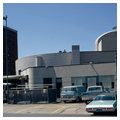The Greyhound Bus Terminal is one of the city's preeminent surviving Art Moderne buildings and one of the outstanding Greyhound bus stations in the nation. The architect designed dozens of other Greyhound terminals elsewhere in the country. In form, his buildings are symbols of the speed, efficiency, excitement, and modernity of passenger bus lines.
The building's curved surfaces can be appreciated in their entirety because the building was a freestanding “island unit.” Constructed of reinforced concrete, it is faced with Indiana limestone and terracotta on the street frontage. Its tall entrance and clock tower in the center of the building bisect the curved walls of the building. A speeding greyhound dog originally capped the tower as well as the curved walls above the second story. A loading dock and concourse were located at the rear.
Ringing the circular waiting room were ticket offices, shops, and concession stands. In 1989, as part of an effort to preserve the building and construct a harmonious rear addition, sheet-metal cladding added in 1976 was removed, revealing the building's intact form and materials.

























